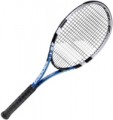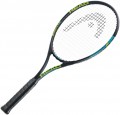Frame material
The material from which the racket frame is made. Today, the most popular are two solutions: aluminium alloy and carbon (graphite).
Aluminium alloy is the simplest, most affordable and reliable solution, which nevertheless is not very popular in modern sports. The advantage of aluminium rackets is their long service life and good resistance to mechanical damage — it is quite difficult to break them on the court. Most often used in the production of children's rackets.
Carbon (graphite) is the most popular material today for making tennis rackets, both professional and amateur. It boasts low weight and good strength. It is quite rare that rackets are made from pure carbon; more often, various metal alloys are used (carbon, titanium, etc.), and each manufacturer has its own “recipe” for the ideal alloy.
String surface area
There is a simple pattern here: the larger the area of the string surface and the lower the rigidity of the string tension, the higher the impact force and the lower its accuracy. This parameter is directly related to the string formula.
Now on the market there are rackets with the following string surface area:
Midsize (452 – 574 cm²),
Midplus (580 – 677 cm²),
Oversize (710 – 742 cm²).
String pattern
A string pattern is a scheme for stretching racquet strings. Represents two numbers: the first of them is the number of longitudinal strings, and the second is the number of transverse ones. A racquet with a lower string density will provide more power, while a higher density racquet will provide better ball control. It is important to pay attention to the fact that the same string pattern on rackets with different head areas will provide different stiffness. For example, a racquet with a Midplus head and a 16x19 formula will be stiffer than a similar model with an Oversize head.
Handle size
It is customary to read that the thickness of a tennis racquet should be such that when it is grasped between the fingers and the palm there is a gap slightly larger than the thickness of the index finger. There are two generally accepted systems for measuring handle thickness: American and European. If within the first one, the indicator is measured in inches, then within the European one — in integers from 0 to 5, where zero is the smallest size. Usually, each racquet is presented on the market with modifications with a different handle diameter. So, the indicator "1-5" means that the model is represented by modifications with a handle diameter of 1, 2, 3, 4, 5. Exceptions may be some children's rackets, for which the manufacturer sometimes does not indicate the diameter of the handle, since it is less than size 0.
Weight
As the weight of the racquet increases, the impact force increases, but its accuracy decreases. On the contrary, it is easier to swing
with a light rocket, but at the same time, the player needs to make more effort to give the ball the desired speed.

